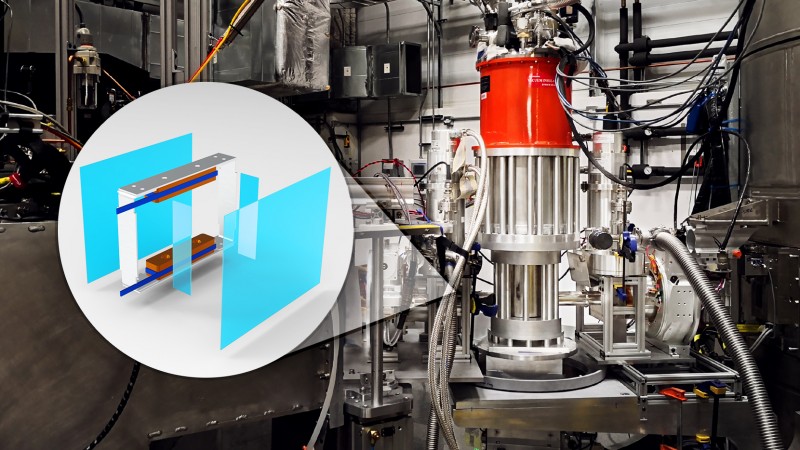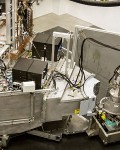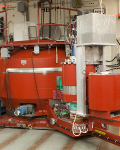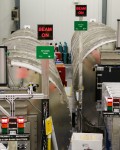Understanding magnetism at its most fundamental level is vital to developing more powerful electronics, but materials with more complex magnetic structures require more complex tools for studying them—powerful tools simply referred to as “neutrons.”
Two of the world’s most powerful sources for neutron scattering at the US Department of Energy’s (DOE’s) Oak Ridge National Laboratory (ORNL) are getting upgrades. Adding an advanced capability called spherical neutron polarimetry will enable researchers using ORNL’s High Flux Isotope Reactor (HFIR) and Spallation Neutron Source (SNS) to make measurements of materials featuring exotic magnetic structures and quantum states that were previously inaccessible in the United States.
“Neutrons are ideal for studying magnetic phenomena,” said ORNL post-masters researcher Nicolas Silva. “They’re electrically neutral, or have no charge, and exhibit magnetic moments, which sort of make them like tiny magnets themselves.”
When neutrons pass through a material and scatter off magnetic fields generated by a material’s atoms, they paint an atomic portrait or even a 3D model of the material’s atomic arrangement and reveal how the atoms within the system are behaving.
Neutrons have a “spin,” or orientation, like the north and south poles of refrigerator magnets. In a typical neutron beam, the neutrons within the beam have spins that are arranged randomly. Measuring certain highly dynamic or complex magnetic systems, however, requires more uniformity, which is provided by a polarized neutron beam in which each neutron spin is aligned in parallel and with the same orientation.
“Neutron polarization filters allow us to see through the stuff we don’t want to see that might be muddying up the signal we’re interested in,” said instrument scientist Barry Winn. “Similar to how polarized lenses allow anglers to see fish swimming below that would be otherwise blocked by the water’s reflection.”
Neutrons will change their spins in predictable ways when they scatter. Using a polarized beam enables researchers to better understand what’s happening in a material by establishing the neutron spin before and measuring the neutron spin after the beam strikes the sample. For example, a neutron’s spin could be flipped in the opposite direction during scattering.
“In the US, most of the measurements we’ve been doing with polarized neutrons until now have been based on whether the neutron, after being scattered from the material or its magnetic field, gets rotated 180 degrees or preserves its orientation. We call that spin-flip and non-spin-flip,” said Winn.
“But there’s a problem with that. If we get any scattering off the sample that’s something other than a non-spin-flip or spin-flip—or something other than 0 and 180 degrees—then the strategy blows up in our face.”
The strategy works well for conventional magnetic materials such as ferromagnets and antiferromagnets, in which all the magnetic atoms are pointing either in the same direction or in alternate directions, but remain parallel to their neighbors. However, the strategy does not work for more complex magnetic structures.
For example, the technique is limited when it comes to investigating exotic particles such as skyrmions—quasi-particles that exhibit chiral motion, or tangled vortices, or whirlpools of asymmetric field lines. Such particles provide exciting potential for materials used in advanced data storage and quantum computing applications.
To tackle the problem, polarization scientist Peter Jiang is leading an ORNL team including Winn and Silva in a laboratory directed research and development project to develop spherical neutron polarimetry for multiple ORNL beamlines. The technology will enable neutron measurements of materials that don’t conform to the traditional spin-flip and non-spin-flip domains, or, in other words, will enable researchers to see the dynamical magnetic behavior that exists in between.
“The traditional techniques are not sophisticated enough to study certain complex magnetic systems,” said Jiang. “Now, we’re no longer restricted to spin-flips. This allows us to look at magnetic arrangements that we weren’t able to figure out before.”
Spherical neutron polarimetry has been used in Europe, and now Jiang and the ORNL team are adapting the technology to instruments at SNS and HFIR. They’re building the technology based on ongoing research conducted by Tianhao Wang, first as a graduate student at Indiana University, Bloomington, and later as a postdoctoral research on the ORNL team.
The basic technology incorporates additional optical devices installed on both the incoming beam that hits the sample—the incident beam—and the outgoing beam that scatters off it, which enables measurements of scattered neutrons oriented in any direction. The ORNL technology builds on previous prototype designs and will offer several innovations.
With the ORNL spherical neutron polarimetry devices, the scattered beam trajectory need not be in line with the incident beam but instead can be angled around the sample.
“That means if the neutron doesn’t experience a full flip, we can adjust the field on the other end, or move the apparatus to detect neutrons scattering in different directions,” explained Silva.
The team also developed two independent cooling systems to enable researchers to study how magnetic structures change as a function of temperature. The first system cools two spherical neutron polarization components located on either side of the sample to make them superconducting. The second system introduces an extra cryostat with liquid helium auto-refilling capability that allows researchers to more easily explore materials under a range of temperatures without interfering with the temperatures required for superconductivity in the first system.
Finally, the spherical neutron polarimetry devices are made with more efficient materials. Whereas previous designs use niobium for the superconducting sheets, the new design uses an yttrium-barium-copper-oxide (YBCO) that superconducts at 93 Kelvin (-292° F), a significantly higher temperature than its niobium predecessor. Additionally, the superconducting films are coupled with Mu-metal yokes that combine to shield all other magnetic fields and establish a zero field around the sample to study the materials’ spins in their natural state.
“Reaching superconductivity requires a significant amount of cooling power. Niobium needs to be cooled to below 10 K to maintain superconductivity, so the European designs required extensive cooling systems that had to be manually refilled with liquid helium often,” said Jiang.
“With the high-temperature YBCO films, we can use a single-stage closed-cycle refrigerator to cool the film to far below its critical temperature, so we’re not worried about any loss in superconductivity. And, with the added liquid helium autofill system for the cryostat and the closed-cycle refrigeration system, the device will be easier to use and more efficient.”
What’s more, the system is compact by comparison with previous systems—the high-temperature superconductors that negate the need for a large cooling system make it mobile.
“If anything, there’s a testament to how portable the device is. We’ve moved it to the nuclear reactor at the University of Missouri, then back to HFIR, and from HFIR to SNS,” said Silva. “I’ve put it together and taken it apart multiple times, and each time I’ve found easier ways to connect the pieces—just little quality-of-life changes we’re making to enhance its utility.”
The system has been successfully tested, wherein full polarization measurements were made using several known materials including silicon, manganese-oxide, and bismuth-iron-oxide.
The team plans to implement the system at HFIR’s PTAX triple axis spectrometer and the GP-SANS diffractometer, which will be optimized for the reactor’s steady-state neutron beam, with full capabilities expected by the end of 2020.
Subsequently, the team will develop a similar spherical neutron polarimetry device exclusively for the HYSPEC instrument at SNS which will make it the only instrument in the world that couples a super-mirror array and wide-angle capability. The device will also benefit from the unique capabilities enabled by the SNS pulsed-source accelerator.
“In the meantime,” said Winn, “we’re going to have a workhorse in PTAX that’s going to knock our socks off.”
HFIR and SNS are DOE Office of Science User Facilities. UT-Battelle LLC manages ORNL for the DOE Office of Science. The Office of Science is the single largest supporter of basic research in the physical sciences in the United States and is working to address some of the most pressing challenges of our time. For more information, please visit energy.gov/science.—by Jeremy Rumsey











